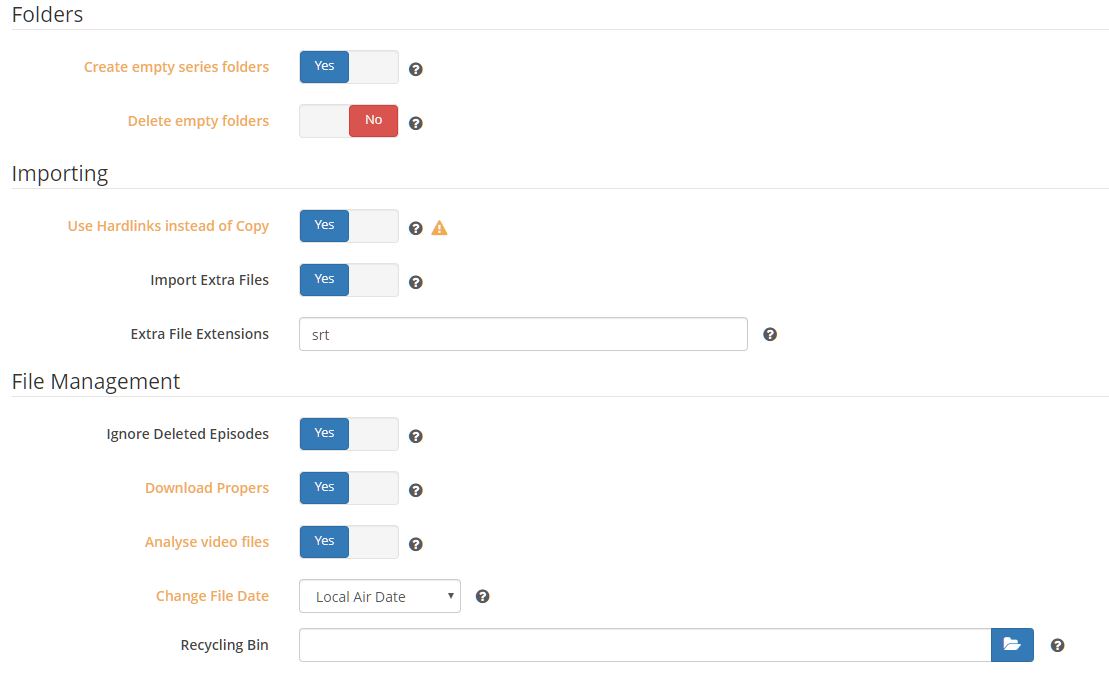

You should also view your container’s logs to verify that it started up properly. If not, there was probably an issue with your configuration. The output of that command should be similar to this: CONTAINER ID IMAGE ac50395c00ec docker.io/linuxserver/sonarr:latestĮnsure that the STATUS column shows that your container is running. Once the image downloads and starts up, you should run podman ps to verify your install. This might differ depending on which image you chose above. For more information on what each flag does, see the image’s overview page. You might need to change the parameters passed in based on your setup. Run the below command to pull the container image and create a new instance of Sonarr: podman run \ -name=sonarr \ -detach \ -e PUID=$MEDIA_UID \ -e PGID=$MEDIA_GID \ -e TZ=America/New_York \ -p 8989:8989 \ -v /media/Sonarr:/config \ -v /media/TV\ Shows:/tv \ -v /media/Downloads:/downloads \ -restart always \ linuxserver/sonarr
#Nzbget directories install#
# create folder to store Sonarr configuration files mkidr /media/Sonarr # create folder for downloads mkdir /media/Downloads # create folder for your library mkdir /media/TV\ Shows # again, transfer ownership to the `media` user podman unshare chown -R $ MEDIA_UID:$ MEDIA_GID /media Sonarr Install Command We’re going to need to create sub-directories within our /media directory to separate our configurations from our downloads and library files. A link to the latest Docker image can be found here: This simplifies the installation process as we can run a single command to get an configured instance of your application running.
#Nzbget directories software#
We’re going to install our media software using containers. See: Running Rootless Podman as a Non-Root User, and Rootless Podman and NFS Installing Your First Service Since the filesystem has no concept of user namespaces, we have to rely on these user and group id mappings to control access across namespaces. Output of `ls -al /media` by the end of this guide. This is because Podman has set the owner of that directory to the user id of media within to the Podman namespace. If you now run ls -al on the /media directory you should see an id in the hundred of thousands, e.g. # assign id of `media` user to MEDIA_UID MEDIA_UID=$(id -u media) # assign id of `media` group to MEDIA_GID MEDIA_GID=$(id -g media) # change ownership in podman namespace podman unshare chown $ MEDIA_UID:$ MEDIA_GID /media To enter the Podman namespace, we use the podman unshare command. This namespace has its own set of user and group ids that map to your user session ids. However, Podman runs in a different user namespace then your user session. In order to run this container rootless, we need to set ownership of this directory to the media user and group. # create directory sudo mkdir /media # make yourself the owner sudo chown $(id -u -n):$(id -g -n) /media If you prefer, you can use a container volume which might simplify the setup but I find it less convenient for managing my files directly from my host machine. Note: in this guide, we are setting up a bind mount.

This is where both the application configurations and downloaded files will be stored. We’ll create a directory at the root of the filesystem called /media. Now that we have a new user and group, we need to create a place for this user and group to store files.

# create user, `-M` prevents home directory creation for this user sudo useradd -M media # create group sudo groupadd media # add user to group sudo usermod -a -G media media We then add it to a new a group, also called media. For this guide, we create a user called media. This is recommended to limit the service privileges in the event that someone malicious gains access to them. Next, we need to create a user and group to run your media services from. For example, to see your running containers, run: # same as running `docker ps -a` podman ps -s As mentioned before, podman commands are compatible with docker commands. Verify your install by running podman version. sudo dnf install -y podmanīy installing with sudo both root and regular users will have access to Podman. The first thing we want to do is install Podman. Please check out the links I’ve provided throughout this guide to familiarize yourself with the technologies involved. I created this guide after stumbling through getting these media services setup on my own and am in no way a Linux or containerization expert. This article is intended for educational purposes. The goal of this guide is to get the above services running in containers Disclaimer


 0 kommentar(er)
0 kommentar(er)
